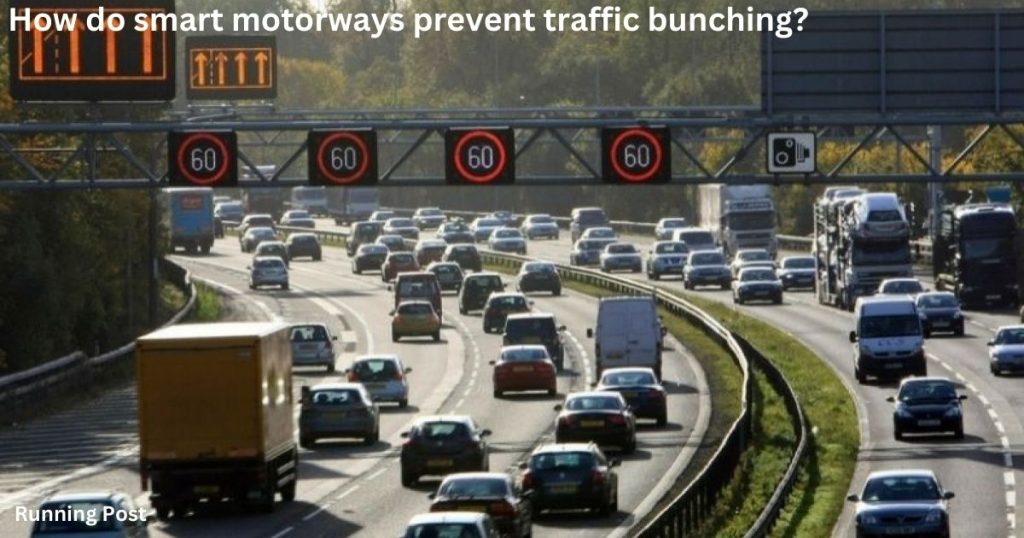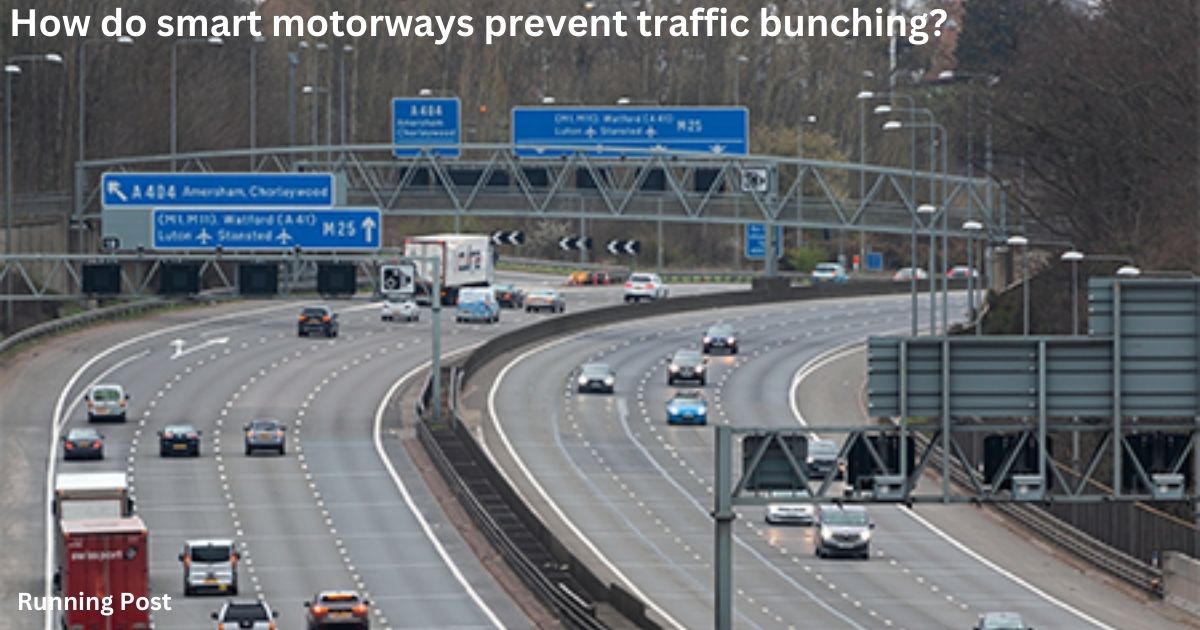| A: By using variable speed limits | B: By using minimum speed limits | C: By using advisory speed limits | D: By using higher speed limits |
How Smart Motorways Prevent Traffic Bunching
Introduction
Brief Overview of Smart Motorways
Smart motorways represent a significant evolution in traffic management, designed to enhance the efficiency and safety of road networks. These advanced systems integrate various technologies to improve traffic flow and reduce congestion. Unlike traditional motorways, which rely solely on fixed lane designs and static speed limits, smart motorways use dynamic measures to adapt to real-time traffic conditions. By incorporating elements such as variable speed limits, lane management, and real-time data collection, they aim to create a more responsive and fluid driving experience. The primary goal is to optimize the use of existing road infrastructure, minimize delays, and ensure a smoother journey for all road users.
Importance of Preventing Traffic Bunching
Traffic bunching, where vehicles cluster together and form congested groups, can severely impact road efficiency and driver comfort. This phenomenon not only leads to slower travel times but also increases the likelihood of accidents due to reduced reaction times and increased stress. Preventing traffic bunching is crucial for maintaining smooth traffic flow, reducing travel delays, and improving overall road safety. By addressing the factors that contribute to bunching, smart motorways aim to alleviate these issues and provide a more consistent and reliable driving experience.
What Are Smart Motorways?
Definition and Basic Concepts
Smart motorways are a modern approach to managing road traffic through the use of advanced technology and real-time data. They incorporate features such as variable speed limits, lane management systems, and dynamic signage to adapt to current traffic conditions. The core idea is to utilize the existing road infrastructure more effectively, rather than building new roads. This approach involves real-time monitoring and responsive adjustments to optimize traffic flow and reduce congestion.
Key Features of Smart Motorways
Smart motorways are characterized by several key features:
- Variable Speed Limits: Adjusted based on traffic conditions to maintain smooth flow.
- Dynamic Lane Management: Uses lane availability to manage traffic volume and prevent congestion.
- Real-Time Traffic Information: Collected through sensors and cameras to provide up-to-date information to drivers.
- Incident Detection and Management: Rapid identification and response to accidents or breakdowns to minimize disruption.
How Do Smart Motorways Prevent Traffic Bunching?

Variable Speed Limits
Explanation of Variable Speed Limits
Variable speed limits are a fundamental component of smart motorways. These limits adjust based on current traffic conditions, aiming to smooth out traffic flow and prevent bottlenecks. When traffic volume is high, speed limits are lowered to reduce the likelihood of congestion and maintain a steady flow of vehicles. Conversely, when traffic is lighter, speed limits may be increased to maximize road use efficiency. This dynamic approach helps to prevent the formation of traffic bunching by ensuring that vehicles travel at speeds conducive to maintaining a consistent flow.
How They Regulate Traffic Flow
By adapting speed limits in response to real-time traffic conditions, smart motorways can prevent the sudden fluctuations in vehicle speed that often lead to traffic bunching. For example, if a section of the motorway experiences a surge in traffic, the system may lower the speed limit to reduce the likelihood of vehicles clustering together. This helps to smooth out traffic flow and prevent the build-up of congestion. Additionally, by maintaining a more consistent speed, vehicles are less likely to experience sudden stops and starts, which can contribute to bunching.
Lane Management
Dynamic Lane Usage
Dynamic lane usage is another key feature of smart motorways. This system allows for the reallocation of lanes based on current traffic needs. For instance, some lanes may be designated as “hard shoulder” lanes during peak times to accommodate increased traffic flow. This flexibility helps to manage traffic volumes more effectively and prevents the formation of congested areas. By adjusting lane availability, smart motorways can adapt to changing traffic conditions and reduce the likelihood of traffic bunching.
Benefits of Lane Reallocation
Lane reallocation offers several benefits, including improved traffic flow and reduced congestion. By providing additional lanes during peak times, smart motorways can accommodate more vehicles and prevent the build-up of traffic. This approach also helps to balance traffic volumes across the motorway, reducing the risk of congestion in specific areas. Overall, lane reallocation contributes to a smoother driving experience and helps to prevent the formation of traffic bunching.
Real-Time Traffic Information
Use of Sensors and Cameras
Smart motorways rely on a network of sensors and cameras to monitor traffic conditions in real time. These devices collect data on vehicle speed, traffic volume, and road conditions, which is used to make informed decisions about traffic management. By analyzing this data, smart motorways can adjust speed limits, manage lane usage, and provide timely information to drivers. This real-time monitoring helps to prevent traffic bunching by ensuring that traffic management measures are responsive to current conditions.
Impact on Driver Behavior
Real-time traffic information provided by smart motorways has a significant impact on driver behavior. When drivers receive up-to-date information about traffic conditions, they can adjust their driving accordingly. For example, if a smart motorway indicates that traffic is moving slowly ahead, drivers may choose to reduce their speed or change lanes to avoid congestion. This increased awareness and adaptability help to maintain a smoother traffic flow and prevent the formation of traffic bunching.
You Also Like It:
What does the white line along the side of the road indicate?
Which vehicle will use a blue flashing beacon?
What shape is a ‘give way’ sign?
What Is the Aim of a Smart Motorway?
Enhancing Road Efficiency
One of the primary aims of smart motorways is to enhance road efficiency. By optimizing the use of existing road infrastructure, smart motorways can accommodate more traffic and reduce delays. This approach helps to make better use of the available road space and ensures that traffic flows more smoothly. Enhanced road efficiency leads to shorter travel times and a more reliable driving experience.
Reducing Congestion and Delays
Reducing congestion and delays is a key objective of smart motorways. By implementing measures such as variable speed limits and dynamic lane management, smart motorways can prevent the build-up of traffic and maintain a steady flow of vehicles. This helps to minimize delays and reduce the overall level of congestion on the motorway. As a result, drivers experience fewer disruptions and a more efficient journey.
Improving Safety for Drivers
Improving safety is another important aim of smart motorways. By reducing congestion and preventing traffic bunching, smart motorways help to lower the risk of accidents and improve overall road safety. Additionally, features such as real-time traffic information and incident detection systems contribute to a safer driving environment by providing timely warnings and facilitating quick responses to potential hazards.
How to Prevent Traffic Bunching?
General Strategies for Traffic Management
Preventing traffic bunching involves several strategies for effective traffic management. Key approaches include implementing variable speed limits, optimizing lane usage, and using real-time traffic data to inform decision-making. Additionally, educating drivers about best practices for maintaining a smooth flow, such as avoiding sudden stops and maintaining safe following distances, can contribute to preventing traffic bunching.
Role of Technology and Infrastructure
Technology and infrastructure play a crucial role in preventing traffic bunching. Smart motorways use advanced systems such as sensors, cameras, and dynamic signage to monitor and manage traffic flow. By integrating these technologies into road infrastructure, smart motorways can adapt to real-time conditions and address issues such as congestion and traffic bunching more effectively.
Importance of Driver Awareness
Driver awareness is essential for preventing traffic bunching. When drivers are aware of the impact of their behavior on traffic flow, they are more likely to adopt practices that promote smoother driving. For example, maintaining a consistent speed, avoiding sudden lane changes, and being attentive to traffic conditions can help prevent the formation of traffic bunching. Education and awareness campaigns can help to encourage these behaviors and improve overall traffic management.
How to Avoid Smart Motorways
Reasons Some Drivers Might Prefer to Avoid Them
Some drivers might prefer to avoid smart motorways due to concerns about unfamiliar technology, potential increased congestion during peak times, or the perceived complexity of dynamic lane management systems. Additionally, drivers who are uncomfortable with changing speed limits or lane allocations may choose alternative routes to avoid these features.
Alternatives to Smart Motorways
There are several alternatives to smart motorways for drivers who wish to avoid them. These may include taking secondary roads or routes that do not feature smart motorway technologies. While these alternatives may not always offer the same level of efficiency as smart motorways, they can provide a more predictable driving experience for those who prefer not to use smart motorways.
Tips for Navigating Around Smart Motorways
Navigating around smart motorways can be challenging, but there are several tips that can help. Using GPS navigation systems and traffic apps can provide real-time information on alternative routes and traffic conditions. Additionally, planning journeys in advance and allowing extra time for potential delays can help to ensure a smoother trip. Being aware of road signs and following updated traffic information can also assist in avoiding smart motorways when necessary.
Conclusion About How do smart motorways prevent traffic bunching?
Summary of Key Points
Smart motorways are designed to improve traffic flow and reduce congestion through the use of advanced technologies such as variable speed limits, dynamic lane management, and real-time traffic information. These features work together to prevent traffic bunching and enhance overall road efficiency. By addressing traffic management challenges and incorporating responsive measures, smart motorways contribute to a smoother and safer driving experience.
Future of Smart Motorways and Traffic Management
The future of smart motorways looks promising, with ongoing advancements in technology and data analysis poised to further enhance traffic management. As smart motorway systems continue to evolve, they are expected to offer even more efficient solutions for preventing congestion and improving road safety. Future developments may include more sophisticated sensors, enhanced data integration, and further innovations in traffic management strategies. The continued focus on improving road infrastructure and technology will play a crucial role in shaping the future of smart motorways and traffic management.
ou Also Like It:
What’s the purpose of triangular shaped signs?
In which THREE of these situations may you overtake another vehicle on the left?
Releated Posts
MAB Instructor Certification: Your Gateway to Professional Crisis Management Leadership
In today’s fast-evolving professional environments—especially in healthcare, mental health, education, and corrections—conflict and aggression can arise without warning.…
Freewayget.com: Your Ultimate Platform for Deals, Discounts, and Digital Products
Introduction to Freewayget.com In today’s fast-paced digital world, finding reliable platforms that offer authentic discounts, deals, and digital…
Affordable & Fast Embroidery Digitizing Services in Your Area
Embroidery digitizing services provide corporations, designers, and people with brilliant embroidery-equipped designs by means of changing art work…
Introduction to hdhub4u nit
In this article, we will delve into the details of hdhub4u nit, exploring its features, benefits, and why…

















